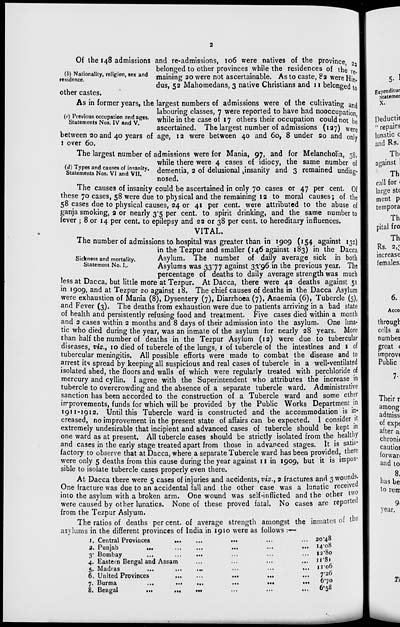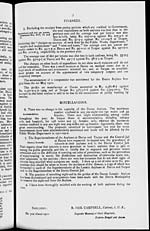Medicine - Mental health > 1903-1911 - Triennial report on the lunatic asylums in the province of Eastern Bengal and Assam > Statistical returns of the lunatic asylums in Eastern Bengal and Assam for the year 1910
(194) Page 2
Download files
Individual page:
Thumbnail gallery: Grid view | List view

2
(b) Nationality, religion, sex and
residence.
Of the 148 admissions and re-admissions, 106 were natives of the province 22
belonged to other provinces while the residences of the re.
maining 20 were not ascertainable. As to caste, 82 were Hin.
dus, 52 Mahomedans, 3 native Christians and 11 belonged to
other castes.
(c) Previous occupation and ages.
Statements Nos. IV and V.
As in former years, the largest numbers of admissions were of the cultivating and
labouring classes, 7 were reported to have had nooccupation,
while in the case of 17 others their occupation could not be
ascertained. The largest number of admissions (127) were
between 20 and 40 years of age, 12 were between 40 and 60, 8 under 20 and only
1 over 60.
(d) Types and causes of insanity.
Statements Nos. VI and VII.
The largest number of admissions were for Mania, 97, and for Melancholia, 38,
while there were 4 cases of idiocy, the same number of
dementia, 2 of delusional insanity and 3 remained undiag-
nosed.
The causes of insanity could be ascertained in only 70 cases or 47 per cent. Of
these 70 cases, 58 were due to physical and the remaining 12 to moral causes; of the
58 cases due to physical causes, 24 or 41 per cent. were attributed to the abuse of
ganja smoking, 2 or nearly 3.5 per cent. to spirit drinking, and the same number to
fever ; 8 or 14 per cent, to epilepsy and 22 or 38 per cent. to hereditary influences.
VITAL.
Sickness and mortality.
Statement No. I..
The number of admissions to hospital was greater than in 1909 (154 against 132)
in the Tezpur and smaller (146 against 183) in the Dacca
Asylum. The number of daily average sick in both
Asylums was 33.77 against 33.96 in the previous year. The
percentage of deaths to daily average strength was much
less at Dacca, but little more at Tezpur. At Dacca, there were 42 deaths against 51
in 1909, and at Tezpur 20 against 18. The chief causes of deaths in the Dacca Asylum
were exhaustion of Mania (8), Dysentery (7), Diarrhoea (7), Anaemia (6), Tubercle (5),
and Fever (3). The deaths from exhaustion were due to patients arriving in a bad state
of health and persistently refusing food and treatment. Five cases died within a month
and 2 cases within 2 months and 8 days of their admission into the asylum. One luna-
tic who died during the year, was an inmate of the asylum for nearly 28 years. More
than half the number of deaths in the Tezpur Asylum (12) were due to tubercular
diseases, viz., 10 died of tubercle of the lungs, 1 of tubercle of the intestines and 1 of
tubercular meningitis. All possible efforts were made to combat the disease and to
arrest its spread by keeping all suspicious and real cases of tubercle in a well-ventilated
isolated shed, the floors and walls of which were regularly treated with perchloride of
mercury and cyllin. I agree with the Superintendent who attributes the increase in
tubercle to overcrowding and the absence of a separate tubercle ward. Administrative
sanction has been accorded to the construction of a Tubercle ward and some other
improvements, funds for which will be provided by the Public Works Department in
1911-1912. Until this Tubercle ward is constructed and the accommodation is in-
creased, no improvement in the present state of affairs can be expected. I consider it
extremely undesirable that incipient and advanced cases of tubercle should be kept in
one ward as at present. All tubercle cases should be strictly isolated from the healthy
and cases in the early stage treated apart from those in advanced stages. It is satis-
factory to observe that at Dacca, where a separate Tubercle ward has been provided, there
were only 5 deaths from this cause during the year against 11 in 1909, but it is impos-
sible to isolate tubercle cases properly even there.
At Dacca there were 5 cases of injuries and accidents, viz., 2 fractures and 3 wounds.
One fracture was due to an accidental fall and the other case was a lunatic received
into the asylum with a broken arm. One wound was self-inflicted and the other two
were caused by other lunatics. None of these proved fatal. No cases are reported
from the Tezpur Aslyum.
The ratios of deaths per cent. of average strength amongst the inmates of the
asylums in the different provinces of India in 1910 were as follows :—
|
1. Central Provinces ... ... ... ... ... |
20.48 |
|
2. Punjab ... ... ... ... ... ... |
14.08 |
|
3. Bombay ... ... ... ... ... ... |
12.80 |
|
4. Eastern Bengal and Assam ... ... ... ... |
11.81 |
|
5. Madras ... ... ... ... ... ... |
11.06 |
|
6. United Provinces ... ... ... ... ... ... |
7.26 |
|
7. Burma ... ... ... ... ... ... |
6.70 |
|
8. Bengal ... ... ... ... ... ... |
6.58 |
Set display mode to: Large image | Zoom image | Transcription
Images and transcriptions on this page, including medium image downloads, may be used under the Creative Commons Attribution 4.0 International Licence unless otherwise stated. ![]()
| Permanent URL | https://digital.nls.uk/83166879 |
|---|



![[Page 1]](https://deriv.nls.uk/dcn4/8316/83166878.4.jpg)
